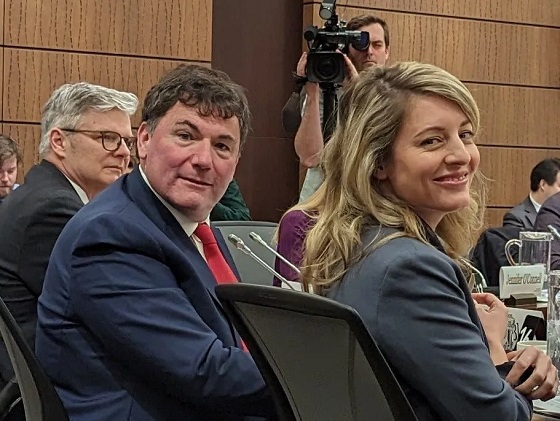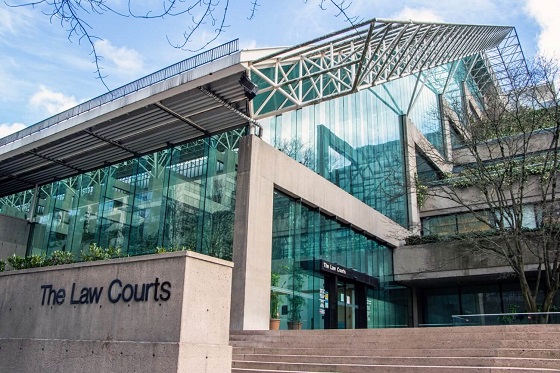Business
List of items Canadians will pay 25% tariffs on includes US made orange juice, wine, beer, and clothing

From the Department of Finance Canada
Canada Announces $155B Tariff Package in Response to U.S. Tariffs
Dominic LeBlanc, Minister of Finance and Intergovernmental Affairs, and Mélanie Joly, Minister of Foreign Affairs, announced that the Government of Canada is moving forward with 25 per cent tariffs on $155 billion worth of goods in response to the unjustified and unreasonable tariffs imposed by the United States (U.S.) on Canadian goods.
These countermeasures have one goal: to protect and defend Canada’s interests, consumers, workers, and businesses.
The first phase of our response will include tariffs on $30 billion in goods imported from the U.S., effective February 4, 2025, when the U.S tariffs are applied. The list includes products such as orange juice, peanut butter, wine, spirits, beer, coffee, appliances, apparel, footwear, motorcycles, cosmetics, and pulp and paper. A detailed list of these goods will be made available shortly.
Minister LeBlanc also announced that the government intends to impose tariffs on an additional list of imported U.S. goods worth $125 billion. A full list of these goods will be made available for a 21-day public comment period prior to implementation, and will include products such as passenger vehicles and trucks, including electric vehicles, steel and aluminum products, certain fruits and vegetables, aerospace products, beef, pork, dairy, trucks and buses, recreational vehicles, and recreational boats.
In addition to this initial response, Ministers LeBlanc and Joly reiterated that all options remain on the table as the government considers additional measures, including non-tariff options, should the U.S. continue to apply unjustified tariffs on Canada.
Less than 1 per cent of the fentanyl and illegal crossings into the United States come from Canada. We will not stand idly by when our nation is being needlessly and unfairly targeted. The government will defend Canadian interests and jobs. We stand ready to support affected workers and businesses.
The U.S. administration’s decision to impose tariffs will have devastating consequences for the American economy and people. Tariffs will upend production at U.S. auto assembly plants and oil refineries, raise costs for American consumers—at gas pumps and grocery stores—and put American prosperity at risk.
The government is also taking steps to mitigate the impact of its tariff countermeasures on Canadian workers and businesses by establishing a remission process to consider requests for exceptional relief from the tariffs imposed as part of Canada’s immediate response, as well as any future tariff actions. More details about the framework and process will be announced in the coming days.
The government continues to work closely with provincial and territorial governments, as well as business, labour, and other leaders to advance a robust Team Canada response, and to advocate with U.S. decision-makers on behalf of all Canadians to safeguard and strengthen Canada’s economy.
“This first set of countermeasures is about protecting—and supporting—Canada’s interests, workers, and industries. These U.S. tariffs are plainly unjustified. They are detrimental to both American and Canadian families and businesses. Working with provincial, territorial and industry partners, our singular focus is to get them removed as quickly as possible. Until then, our response will be balanced and resolute.”
– The Honourable Dominic LeBlanc,
Minister of Finance and Intergovernmental Affairs
“Canada will not stand by as the U.S., our closest and most important trading partner, applies harmful and unjustified tariffs against us. With these countermeasures, we are defending Canada’s interests and are doing what is best for Canadians and our economy.”
– The Honourable Mélanie Joly,
Minister of Foreign Affairs
Quick facts
- Canada is the top customer for U.S. goods and services exports and a critical supplier of goods and services integral to the U.S. economy, with Canada buying more U.S. goods than China, Japan, France and the United Kingdom combined.
- Millions of jobs on both sides of the border depend on this relationship, and every day over US$2.5 billion worth of goods and services crosses the border.
- Canada is the largest export market for 36 states and is among the top three for 46 states, with 43 states exporting over US$1 billion to Canada every year.
- Of the U.S.’s top five trading partners, Canada is the only country with whom the U.S. has a trade surplus in manufacturing (US$33 billion in 2023).
- The tariffs announced today by the Government of Canada will not apply to U.S. goods that are in transit to Canada on the day on which these countermeasures come into force.
- As a first line of defence, Canada’s robust system of economic support programs is available to help businesses and workers directly impacted by U.S. tariffs. This includes financing and advisory supports for businesses through financial Crown corporations and supports for workers through the Employment Insurance program. As we redouble our efforts to improve Canada’s investment, productivity and competitiveness in collaboration with provinces, territories and the business community, the government will proactively monitor impacts across sectors and the economy, and will bring forward additional measures to support workers and businesses as needed.
- On December 17, 2024, the Government of Canada announced Canada’s Border Plan, which aims to bolster border security, strengthen our immigration system, and keep Canadians safe.
- The Plan is backed by an investment of $1.3 billion and built around five pillars: 1) Detecting and disrupting fentanyl trade; 2) Introducing significant new tools for law enforcement; 3) Enhancing operational coordination; 4) Increasing information sharing; and 5) Minimizing unnecessary border volumes.
Business
Virtue-signalling devotion to reconciliation will not end well

From the Fraser Institute
By Bruce Pardy
In September, the British Columbia Supreme Court threw private property into turmoil. Aboriginal title in Richmond, a suburb of Vancouver, is “prior and senior” to fee simple interests, the court said. That means it trumps the property you have in your house, farm or factory. If the decision holds up on appeal, it would mean private property is not secure anywhere a claim for Aboriginal title is made out.
If you thought things couldn’t get worse, you thought wrong. On Dec. 5, the B.C. Court of Appeal delivered a different kind of upheaval. Gitxaala and Ehattesaht First Nations claimed that B.C.’s mining regime was unlawful because it allowed miners to register claims on Crown land without consulting with them. In a 2-to-1 split decision, the court agreed. The mining permitting regime is inconsistent with the United Nations Declaration on the Rights of Indigenous People (UNDRIP). And B.C. legislation, the court said, has made UNDRIP the law of B.C.
UNDRIP is a declaration of the United Nations General Assembly. It consists of pages and pages of Indigenous rights and entitlements. If UNDRIP is the law in B.C., then Indigenous peoples are entitled to everything—and to have other people pay for it. If you suspect that is an exaggeration, take a spin through UNDRIP for yourself.
Indigenous peoples, it says, “have the right to the lands, territories and resources which they have traditionally owned, occupied or otherwise used or acquired… to own, use, develop and control, as well as the right to “redress” for these lands, through either “restitution” or “just, fair and equitable compensation.” It says that states “shall consult and cooperate in good faith” in order to “obtain free and informed consent prior to the approval of any project affecting their lands or territories and other resources,” and that they have the right to “autonomy or self-government in matters relating to their internal and local affairs, as well as ways and means for financing their autonomous functions.”
The General Assembly adopted UNDRIP in 2007. At the time, Canada sensibly voted “no,” along with New Zealand, the United States and Australia. Eleven countries abstained. But in 2016, the newly elected Trudeau government reversed Canada’s objection.
UN General Assembly resolutions are not binding in international law. Nor are they enforceable in Canadian courts. But in 2019, NDP Premier John Horgan and his Attorney General David Eby, now the Premier, introduced Bill 41, the Declaration on the Rights of Indigenous Peoples Act (DRIPA). DRIPA proposed to require the B.C. government to “take all measures necessary to ensure the laws of British Columbia are consistent with the Declaration.” The B.C. Legislature unanimously passed the bill. (The Canadian Parliament passed a similar bill in 2021.)
Two years later, the legislature passed an amendment to the B.C. Interpretation Act. Eby, still B.C.’s Attorney General, sponsored the bill. The amendment read, “Every Act and regulation must be construed as being consistent with the Declaration.”
Eby has expressed dismay about the Court of Appeal decision. It “invites further and endless litigation,” he said. “It looked at the clear statements of intent in the legislature and the law, and yet reached dramatically different conclusions about what legislators did when we voted unanimously across party lines” to pass DRIPA. He has promised to amend the legislation.
These are crocodile tears. The majority judgment from the Court of Appeal is not a rogue decision from activist judges making things up and ignoring the law. Not this time, anyway. The court said that B.C. law must be construed as being consistent with UNDRIP—which is what Eby’s 2021 amendment to the Interpretation Act says.
In fact, Eby’s government has been doing everything in its power to champion Aboriginal interests. DRIPA is its mandate. It’s been making covert agreements with specific Aboriginal groups over specific territories. These agreements promise Aboriginal title and/or grant Aboriginal management rights over land use. In April 2024, an agreement with the Haida Council recognized Haida title and jurisdiction over Haida Gwaii, an archipelago off the B.C. coast formerly known as the Queen Charlotte Islands. Eby has said that the agreement is a template for what’s possible “in other places in British Columbia, and also in Canada.” He is putting title and control of B.C. into Aboriginal hands.
But it’s not just David Eby. The Richmond decision from the B.C. Supreme Court had nothing to do with B.C. legislation. It was a predictable result of years of Supreme Court of Canada (SCC) jurisprudence under Section 35 of the Constitution. That section guarantees “existing” Aboriginal and treaty rights as of 1982. But the SCC has since championed, evolved and enlarged those rights. Legislatures can fix their own statutes, but they cannot amend Section 35 or override judicial interpretation, even using the “notwithstanding clause.”
Meanwhile, on yet another track, Aboriginal rights are expanding under the Charter of Rights and Freedoms. On the same day as the B.C. Court of Appeal decision on UNDRIP, the Federal Court released two judgments. The federal government has an actionable duty to Aboriginal groups to provide housing and drinking water, the court declared. Taxpayer funded, of course.
One week later, at the other end of the country, the New Brunswick Court of Appeal weighed in. In a claim made by Wolastoqey First Nation for the western half of the province, the court said that Aboriginal title should not displace fee simple title of private owners. Yet it confirmed that a successful claim would require compensation in lieu of land. Private property owners or taxpayers, take your pick.
Like the proverb says, make yourself into a doormat and someone will walk all over you. Obsequious devotion to reconciliation has become a pathology of Canadian character. It won’t end well.
Business
Vacant Somali Daycares In Viral Videos Are Also Linked To $300 Million ‘Feeding Our Future’ Fraud


From the Daily Caller News Foundation
Multiple Somali daycare centers highlighted in a viral YouTube exposé on alleged fraud in Minnesota have direct ties to a nonprofit at the center of a $300 million scam, the Minnesota Star Tribune reported Thursday.
The now-infamous videos from YouTube influencer Nick Shirley, posted Dec. 26, showed several purported Somali-run daycare centers receiving millions in taxpayer funds despite little evidence that children were actually present at the facilities. Now it turns out that five of the 10 daycare centers Shirley visited operated as meal sites for Feeding Our Future, the Minnesota-based nonprofit implicated in a massive fraud scheme that has already produced dozens of convictions, the outlet reported.
Between 2018 and 2021, those five businesses received nearly $5 million from Feeding Our Future, the outlet reported. While none of the centers in Shirley’s video have been legally accused of wrongdoing, the revelations underscore the sprawling web of fraud engulfing the state. (RELATED: Somalis Reportedly Filled Ohio Strip Mall With Potential Fraudulent Childcare Centers)
Dear Readers:
As a nonprofit, we are dependent on the generosity of our readers.
Please consider making a small donation of any amount here.
Thank you!
🚨 Here is the full 42 minutes of my crew and I exposing Minnesota fraud, this might be my most important work yet. We uncovered over $110,000,000 in ONE day. Like it and share it around like wildfire! Its time to hold these corrupt politicians and fraudsters accountable
We ALL… pic.twitter.com/E3Penx2o7a
— Nick shirley (@nickshirleyy) December 26, 2025
Federal prosecutors have charged over 70 individuals — mostly from the Somali community — with stealing more than $300 million from the Federal Child Nutrition Program through Feeding Our Future. During the COVID-19 pandemic, the program funded sites across Minnesota to provide meals to children. Prosecutors say leaders of Feeding Our Future, along with dozens of associates who ran sponsored “meal sites,” submitted false or inflated meal counts to claim reimbursements.
One facility featured in Shirley’s video, the Minnesota Best Childcare Center, received $1.5 million from Feeding Our Future, according to the Minnesota Star Tribune.
Minnesota Best Childcare Center, which has been licensed by the state since 2013, did not respond to the Daily Caller News Foundation’s request for comment.
Other daycares featured in Shirley’s video have been cited dozens of times for rule violations while continuing to receive millions in state funding. The now-infamous Quality “Learing” Center was cited for 121 violations in the past three years, including for failing to report a “death, serious injury, fire or emergency as required,” according to the Star-Tribune.
The paper’s investigation found that six of the facilities featured by Shirley were either closed or employees did not open their doors.
Following that exposé, which has accumulated more than 135 million views on X, the Trump administration announced it would freeze all childcare disbursements to Minnesota while federal officials review how taxpayer dollars have flowed to licensed providers.
The fraud allegations extend beyond childcare, with prosecutors claiming millions in taxpayer funds were also stolen from Minnesota’s Housing Stabilization Services and autism treatment programs. Federal prosecutors also estimate that as much as half of the roughly $18 billion Minnesota has spent since 2018 on 14 Medicaid programs may have been siphoned off by fraudsters.
Even the state’s assisted living program has come under scrutiny, with Republican state Rep. Kristin Robbins warning that individuals connected to the Feeding Our Future scheme continue to receive millions in taxpayer funds.
-

 Business23 hours ago
Business23 hours agoVacant Somali Daycares In Viral Videos Are Also Linked To $300 Million ‘Feeding Our Future’ Fraud
-

 Energy18 hours ago
Energy18 hours agoThe U.S. Just Removed a Dictator and Canada is Collateral Damage
-

 Haultain Research16 hours ago
Haultain Research16 hours agoTrying to Defend Maduro’s Legitimacy
-

 International24 hours ago
International24 hours ago“Captured and flown out”: Trump announces dramatic capture of Maduro
-

 International23 hours ago
International23 hours agoTrump Says U.S. Strike Captured Nicolás Maduro and Wife Cilia Flores; Bondi Says Couple Possessed Machine Guns
-

 International18 hours ago
International18 hours agoU.S. Claims Western Hemispheric Domination, Denies Russia Security Interests On Its Own Border
-

 International18 hours ago
International18 hours agoUS Justice Department Accusing Maduro’s Inner Circle of a Narco-State Conspiracy
-

 International2 days ago
International2 days agoMaduro says he’s “ready” to talk









